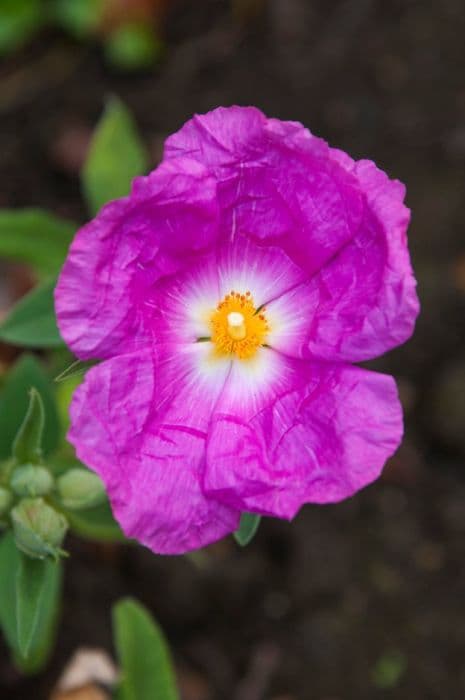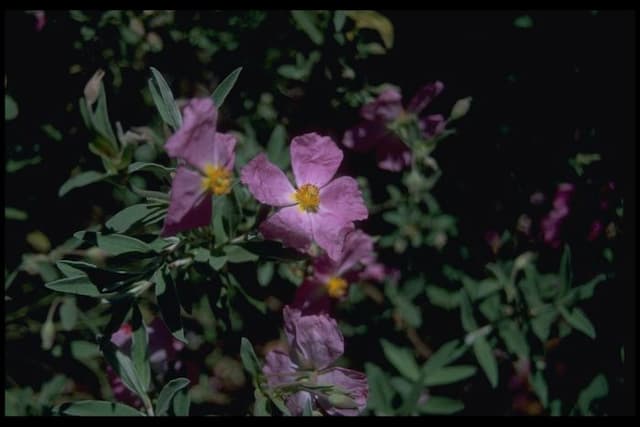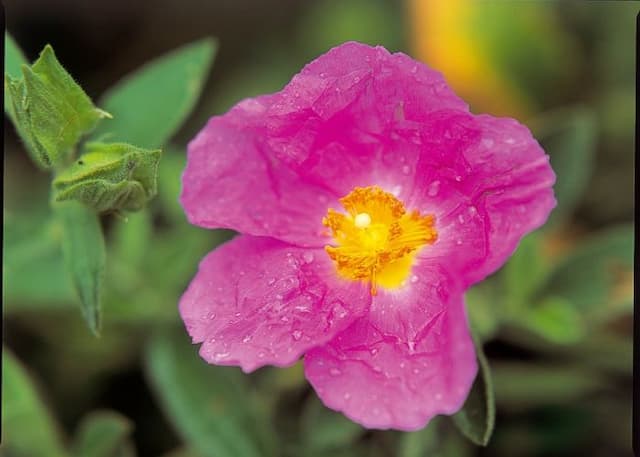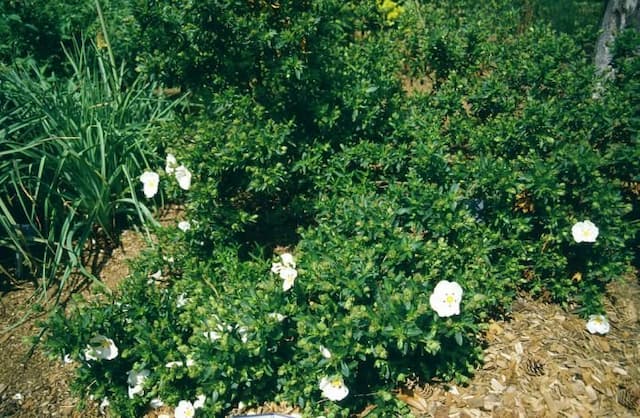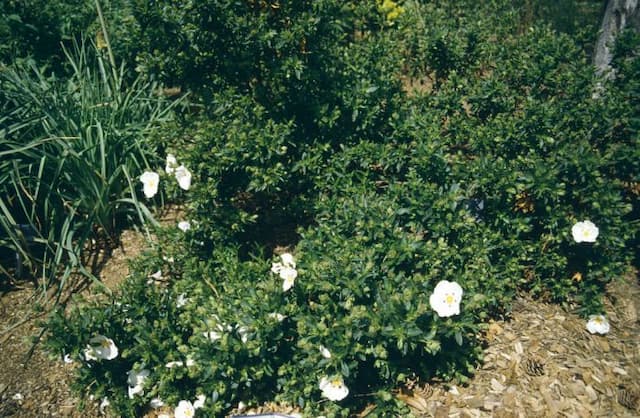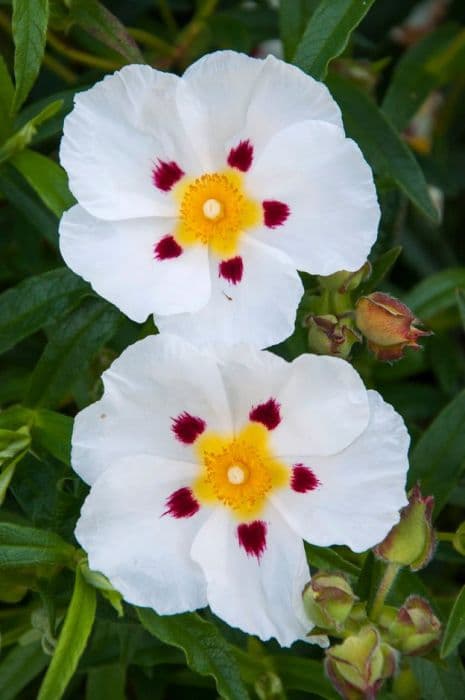Rock Rose Cistus 'Snow Fire'

ABOUT
The Cistus 'Snow Fire', commonly known as the Snow Fire Rockrose, is a visually striking plant with a robust appearance. It showcases a rich display of white flowers, each adorned with a distinctive crimson-red spot at the base of the petals, giving it a fiery look against the snowy bloom. The flowers are numerous and large, often attracting attention in the garden landscape. These blooms are set against a backdrop of evergreen foliage that is typically dark green and slightly wrinkled, adding to the plant's lush appearance. The leaves are arranged in an opposite pattern along the plant's branching stems, which contributes to its bushy and full aesthetic. The juxtaposition of the bold red markings on the white flowers against the green foliage gives this plant a charming and vibrant look that can brighten up any garden space.
About this plant
 Names
NamesSynonyms
Rock Rose, Snow Fire Rock Rose, Cistus 'Snow Fire'.
Common names
Cistus 'Snow Fire'
 Toxicity
ToxicityTo humans
Rockrose 'Snow Fire' is not commonly listed as a toxic plant to humans. Therefore, ingestion of this plant might not cause any significant symptoms of poisoning. However, as with any non-food plant, individual sensitivities can vary, and consuming plant material may cause gastrointestinal discomfort or an allergic reaction in some individuals.
To pets
Rockrose 'Snow Fire' is not commonly known to be toxic to pets. However, it is always advisable to prevent pets from ingesting plants that are not part of their normal diet as they could potentially cause mild stomach upset or an allergic reaction in some animals. No specific symptoms of poisoning from this plant are widely documented.
 Characteristics
CharacteristicsLife cycle
Perennials
Foliage type
Evergreen
Color of leaves
Green
Flower color
White
Height
3 feet (0.91 meters)
Spread
5 feet (1.52 meters)
Plant type
Shrub
Hardiness zones
8
Native area
Mediterranean
Benefits
 General Benefits
General Benefits- Attractive Foliage: Cistus 'Snow Fire' has glossy green leaves that provide year-round interest in the garden.
- Showy Flowers: It produces large, white flowers with a maroon-red blotch at the base of each petal, which are particularly eye-catching during its blooming season in late spring to early summer.
- Drought Tolerance: Once established, Cistus 'Snow Fire' is very drought-tolerant, making it ideal for xeriscaping and in regions with low rainfall.
- Low Maintenance: This plant requires minimal care once established, is generally pest and disease resistant, and does not need frequent pruning.
- Wildlife Attraction: The flowers of Cistus 'Snow Fire' attract pollinators such as bees and butterflies, enhancing the biodiversity of the garden.
- Adaptability: It can thrive in a variety of soil types, though it prefers well-drained soils, and can tolerate coastal conditions and wind.
- Quick Growth: Cistus 'Snow Fire' has a fast growth rate, allowing for swift establishment and coverage in garden settings.
- Fire Resistance: The plant is considered to be fire-resistant, which can be an important feature in fire-prone areas.
 Medical Properties
Medical PropertiesThis plant is not used for medical purposes.
 Air-purifying Qualities
Air-purifying QualitiesThis plant is not specifically known for air purifying qualities.
 Other Uses
Other Uses- Cistus 'Snow Fire', commonly known as Rockrose, can be used in the production of natural plant resin labdanum, which has historically been used in perfumes and fragrances for its warm, amber scent.
- Rockrose can provide a protective ground cover in fire-prone regions due to its fire-resistant property, offering a firebreak in the landscape.
- The dense foliage of Rockrose can be beneficial for erosion control on slopes and banks, helping to maintain soil stability in areas vulnerable to erosion.
- Rockrose is great for attracting bees, butterflies, and other pollinators to the garden, supporting local ecosystems and promoting biodiversity.
- The shrub can be used in thematic gardens such as Mediterranean or drought-resistant landscapes due to its tolerance for dry conditions and heat.
- Rockrose is sometimes used in the floral industry for its attractive blooms, which can add a wild, natural look to floral arrangements and bouquets.
- In arts and crafts, the dried flowers of Rockrose can be used for making potpourri, adding a subtle fragrance to indoor spaces.
- The plant can be used as a living mulch, suppressing weeds by covering the ground with its low-lying foliage, reducing garden maintenance.
- Cistus 'Snow Fire' can be cultivated as bonsai, allowing enthusiasts to enjoy its beauty in miniature form on patios or indoors.
- Its striking flowers and foliage make Rockrose a suitable candidate for ornamental photography, capturing the essence of Mediterranean flora.
Interesting Facts
 Feng Shui
Feng ShuiThe Cistus is not used in Feng Shui practice.
 Zodiac Sign Compitability
Zodiac Sign CompitabilityThe Cistus is not used in astrology practice.
 Plant Symbolism
Plant Symbolism- Resilience: The Cistus plant, commonly referred to as Rockrose, is known for its ability to withstand tough conditions and dry climates, symbolizing the strength and resilience to overcome challenges.
- Purity: The 'Snow Fire' variety, with its crisp white flowers contrasted against a fiery center, could represent purity or the presence of a pure heart amidst adversity or passion.
- Healing: Rockrose has been used in traditional medicine for its healing properties, making it a symbol of recovery and medicinal aid.
- Beauty: With its striking flowers, the Cistus 'Snow Fire' symbolizes beauty, suggesting appreciation for the aesthetic and a reminder of the natural beauty found in the world.
- Renewal: Given that many Cistus species are fire-resistant and some thrive after wildfires, this plant can symbolize renewal or rebirth, arising triumphantly from destruction or hardship.
 Water
WaterRockrose 'Snow Fire' should be watered deeply but infrequently to establish a strong root system; typically, this means watering once a week during the first growing season. Once established, rockrose is drought-tolerant, requiring only occasional deep waterings during prolonged dry spells, potentially just once every two to three weeks. When watering, apply water slowly to the base of the plant, allowing it to soak into the soil, using approximately 1-2 gallons depending on the size of the shrub and the soil moisture level.
 Light
LightRockrose 'Snow Fire' thrives in full sun, meaning it requires at least 6 hours of direct sunlight each day. The best spot for this plant is in an area where it will receive unfiltered sunlight throughout the day, avoiding shaded areas that can impede its growth and flowering.
 Temperature
TemperatureRockrose 'Snow Fire' tolerates a wide range of temperatures, but prefers a cozy Mediterranean climate. It can survive minimum winter temperatures down to about 20 degrees Fahrenheit but fares best in areas where the temperature typically doesn't fall below freezing. The ideal temperature range for this plant is between 50 and 90 degrees Fahrenheit.
 Pruning
PruningRockrose 'Snow Fire' benefits from pruning to shape the plant and encourage bushier growth. Pruning should be done after flowering, typically in late spring or early summer, to remove dead flowers and any undesirable or damaged branches. It is not necessary to prune annually, but a light prune every couple of years can keep your rockrose looking its best.
 Cleaning
CleaningAs needed
 Soil
SoilRockrose 'Snow Fire' thrives best in well-draining soil with a slightly acidic to neutral pH between 6.0 and 8.0. A mix containing equal parts of loam, sand, and peat works well, enhancing drainage while providing organic matter. Additives such as perlite can further increase porosity, ensuring roots are not water-logged.
 Repotting
RepottingRockrose 'Snow Fire' generally has a slow to moderate growth rate and does not need frequent repotting; once every two to three years is usually sufficient. Monitor the plant for signs like roots circling the pot or emerging from drainage holes, indicating it’s time to repot.
 Humidity & Misting
Humidity & MistingRockrose 'Snow Fire' is tolerant of a wide range of humidity levels and does well in the average humidity found in outdoor environments. They do not require high humidity and are quite drought-tolerant once established, making them suitable for drier climates.
 Suitable locations
Suitable locationsIndoor
Provide bright light, well-draining soil, and moderate humidity.
Outdoor
Plant in full sun, well-drained soil, and shelter from harsh winds.
Hardiness zone
8-11 USDA
 Life cycle
Life cycleThe Cistus 'Snow Fire', commonly known as Rockrose, begins its life as a seed, which germinates in warm, well-draining soil typically in spring. After sprouting, the seedling stage follows, during which the Rockrose develops its initial leaves and root system. As it enters the vegetative phase, the plant grows rapidly, forming a dense, bushy shape with dark green foliage. During the flowering stage, usually from late spring to early summer, it produces large, white flowers with a crimson base, which last for only one day but are produced in succession. After pollination, it sets seed and, if conditions are favorable, these seeds will disperse, completing the reproductive cycle. Throughout its lifetime, Rockrose will go through cycles of growth and dormancy, usually marked by the seasons, with active growth in spring and summer followed by a period of dormancy in winter.
 Propogation
PropogationPropogation time
Spring-Early Summer
Cistus 'Snow Fire', also known as Rockrose, is most commonly propagated by semi-hardwood cuttings. The best time for taking these cuttings is in late summer after the bloom period subsides when the new growth starts to firm up. A cutting of about 4 to 6 inches (10 to 15 centimeters) should be taken. The leaves on the lower half of the cutting are stripped off and the cut end is dipped in rooting hormone to enhance rooting success. The prepared cutting is then inserted into a pot filled with a mixture of peat and perlite or sand to provide good drainage. The pot should be placed in a warm environment with indirect sunlight and kept moist until roots develop, which usually takes several weeks. Once rooted, the cuttings can be transplanted into individual pots and grown on before planting out.
